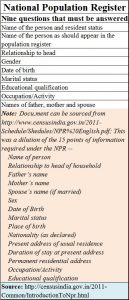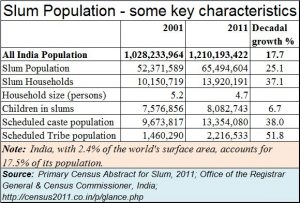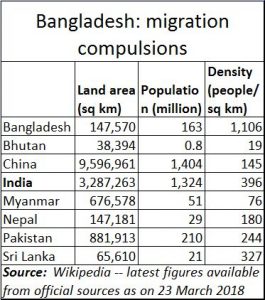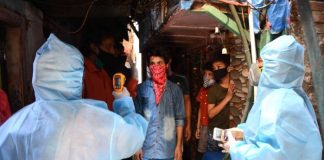https://www.moneycontrol.com/news/india/comment-the-problem-of-citizenship-and-slum-votebanks-and-the-work-permit-solution-2570637.html
Citizenship, votebanks, the Northeast and the need for work permits
RN Bhaskar — May 17, 2018
Last week, the low-hanging clouds burst, both literally and figuratively. Even as rains descended on parts of the Northeast, the whole region rumbled with sounds of protest and consternation.
 The once-dreaded ULFA (United Liberation Front of Assam) raised the banner of revolt with a warning. “We are currently engaged in talks with the government to resolve various issues, primarily being the identity, language and existence of the Assamese people. The Citizenship (Amendment) Bill poses a serious threat to this,” stated ULFA’s pro-talk faction chairman Arabinda Rajkhowa. His views were echoed by ULFA general secretary Anup Chetia who said, “Now if that is again at stake, we cannot continue to have a dialogue. . . We demand that the bill should be immediately withdrawn or else we will be compelled to withdraw from the peace process,” he said. To emphasise that the ULFA had the support of other organisations as well, representatives of the Karbi Longri National Liberation Front (KLNLF), People Democratic Alliance of Kukigram and the National Democratic Front of Bodoland (NDFB) — Ranjan Daimary faction — were also present at the press conference.
The once-dreaded ULFA (United Liberation Front of Assam) raised the banner of revolt with a warning. “We are currently engaged in talks with the government to resolve various issues, primarily being the identity, language and existence of the Assamese people. The Citizenship (Amendment) Bill poses a serious threat to this,” stated ULFA’s pro-talk faction chairman Arabinda Rajkhowa. His views were echoed by ULFA general secretary Anup Chetia who said, “Now if that is again at stake, we cannot continue to have a dialogue. . . We demand that the bill should be immediately withdrawn or else we will be compelled to withdraw from the peace process,” he said. To emphasise that the ULFA had the support of other organisations as well, representatives of the Karbi Longri National Liberation Front (KLNLF), People Democratic Alliance of Kukigram and the National Democratic Front of Bodoland (NDFB) — Ranjan Daimary faction — were also present at the press conference.
The amendment to the bill which was proposed to be passed by the Parliament (it hasn’t been passed as yet) seeks, through a sleight of fine print, to give citizenship to Bangladeshi immigrants. The Citizenship (Amendment) Bill, 2016 was introduced in Lok Sabha last fortnight to amend the Citizenship Act, 1955. A key amendment in the bill seeks to grant citizenship to people without valid documents from minority communities — Hindu, Christians and Jains — from Afghanistan, Bangladesh and Pakistan after six years of residence in India.
Demographic tinkering
Expectedly, ULFA is up in arms. They see in the government’s move an attempt at demographic tinkering.
 It must be mentioned here that the government – irrespective of which party is in power – has finessed the art of demographic tinkering (https://www.moneycontrol.com/news/business/economy/comment-restore-the-primacy-of-passport-for-citizens-and-introduce-work-permits-for-foreigners-in-india-2537423.html). Politicians have done this amazingly well with Mumbai, and with other cities (more on this later). At stake is marginalization of existing voters, capturing a cash cow for political and personal gratification, and allowing politicians to play the same role that a slumlord does – offering protection in exchange of votes. It brings back the horrors of the Nellie Massacre in 1983 (https://en.wikipedia.org/wiki/Nellie_massacre). The threat of secession remains unstated, but is ever-present.
It must be mentioned here that the government – irrespective of which party is in power – has finessed the art of demographic tinkering (https://www.moneycontrol.com/news/business/economy/comment-restore-the-primacy-of-passport-for-citizens-and-introduce-work-permits-for-foreigners-in-india-2537423.html). Politicians have done this amazingly well with Mumbai, and with other cities (more on this later). At stake is marginalization of existing voters, capturing a cash cow for political and personal gratification, and allowing politicians to play the same role that a slumlord does – offering protection in exchange of votes. It brings back the horrors of the Nellie Massacre in 1983 (https://en.wikipedia.org/wiki/Nellie_massacre). The threat of secession remains unstated, but is ever-present.
The ULFA (https://en.wikipedia.org/wiki/United_Liberation_Front_of_Assam) threat is ominous because people still remember the way it had successfully brought to a standstill the entire Northeast for almost a decade. Little oil and less of other goods from the North East reached India. All foreigners were asked to leave the region. Plantations were burnt and so were foreign managers of such plantations (Bengalis were also treated like foreigners). ONCG and Oil India establishments resembled war zones – barricaded and fearful. There was a real danger that the North East would secede from India.
Formed in 1979, ULFA had watched the government pack the Northeastern states with immigrants from both West Bengal and Bangladesh (after the liberation war of 1971 which rechristened East Pakistan as Bangladesh). The ULFA had spearheaded an armed struggle for four decades to protect the identity and existence of the Assamese and other Northeastern tribes. It was even banned as a terrorist organisation by the government in 1990, but the ban was lifted thereafter to facilitate talks. One of the conditions of the talks was the identification of foreigners. To enable that, the National Population Register was formed (http://censusindia.gov.in/2011-Common/IntroductionToNpr.html). And the deal was that all migrants after 1971 would now be identified and deported, or taken to other areas.
But as the chart alongside shows, the information gathering process was diluted. Instead of 15 parameters, the government now wanted only 9 bits of information.
Now the government wants to grant citizenship of all minorities if they have stayed in India for six years.
Earlier, under the provisions of the Citizenship Act, 1955, only those foreigners who could prove that they had stayed in India prior to 1966 were eligible to obtain citizenship of India. As the law states, “Subject to the provisions of sub-section (6) and (7), all persons of Indian origin who came before the 1st day of January, 1966 to Assam from the specified territory (including such of those whose names were included in the electoral rolls used for the purposes of the General Election to the House of the People held in 1967) and who have been ordinarily resident in Assam since the dates of their entry into Assam shall be deemed to be citizens of India as from the 1st day of January, 1966.” Intriguingly, the form for application of citizenship is now no longer available from http://mha1.nic.in/pdfs/CZ-Form-VIII.pdf as indicated by the government on its portal https://indiancitizenshiponline.nic.in/downlableform.htm.
What is a nation?
 The consequences of such a move a fraught with major implications – for the concept of the very nationhood that India is supposed to promote; the rule of fair play and demographic representation in a democracy, and the right to preserve one’s identify, culture and demographic character in any region. In fact, if analysed carefully, the erosion of these new concepts could actually affect the very basic structure of the Constitution of India.
The consequences of such a move a fraught with major implications – for the concept of the very nationhood that India is supposed to promote; the rule of fair play and demographic representation in a democracy, and the right to preserve one’s identify, culture and demographic character in any region. In fact, if analysed carefully, the erosion of these new concepts could actually affect the very basic structure of the Constitution of India.
To understand this, one must study the way the government actually abets the creation of slums. And this is done by all political parties – not necessarily those who have formed the government at present.
A good case study is Mumbai, because it is the financial capital of India, and also because it has been denied much of the money that has been generated from this territory and its people. This charge is similar to the one that Assam and other northeastern starts make – that they have contributed so much to the wealth of India – especially through its tea, oil and agro-produce, not to mention illegal mining – but have got little in return.
Look at the table on slums.
First watch how the slum population for the country has grown at 25% compared to the national population increase of just 17.7%.
Second, watch how slum households have increased faster than slum population. This is obviously the result of the government’s schemes to win the hearts of the marginalised populations. These benefits are given to households, not to people. So each household is entitled to so many units of subsidised power, or a gas cylinder, or other benefits. So two siblings decide to show their units as two households. When you have a policy that is lopsided, you will have people adapting to those policies to create peculiar situations.
Third, watch how slum populations for scheduled castes (SC) and scheduled tribes (ST) have grown faster than the above two categories. There could be a very good explanation for this. When slums get formed, a group of people squat (illegally) on public land. The police can evict them, but don’t because they have been asked not to. Yet when a public-spirited person files a complaint urging the courts to intervene, the best safeguard is to have a group of squatters which puts up a bust of Ambedkar, or Gautam Buddha or even Mayawati. Any action against ST or SC squatters then becomes an act of atrocity against minorities or SC or ST.
Fourth, let a few years pass, and the government seeks to regularise the slum. The squatters are offered free flats – in the very place where their slums are. Hey, just wait a minute! They were illegal squatters, weren’t they? The act of regularisation itself was an act of charity, of kindness, or consideration. But to demand free dwelling in the same area is extortion! But politicians want the votebank in the very place they were nurtured. So squatters get their free flats in the same area.
Fifth, the situation becomes more bizarre when political parties demand that these squatters turned flat-owners should not be asked to pay property tax. Initially, it is for flats under 300 sq ft. Then another legislator comes up and demands that it should be made applicable for flats upto 600 square ft. So now you make the squatters become leeches and parasites on the very economy of Mumbai, where they enjoy benefits but are exempted from paying taxes. All this is done to get their votes. The local stakeholders of Mumbai cannot even protest, because they have now been marginalised.
Consider how Census 2011 showed 43.57% of Mumbai’s population comprising slums. Today, it is closer to 50%. Also remember that cessed buildings (which come under rent control even today) do not pay property taxes at market rates. These buildings account for almost 30% of Mumbai’s real estate. That leaves the burden on just 20%. So you tax the people who actually helped Mumbai grow, and don’t tax those who are free loaders? Is this how India has to become a proud nation?
That is precisely what is happening in Assam and the Northeast. The government has encouraged the slumlord way of governance. That is why it is sensible that ULFA and others protest before they get marginalised.
What about illegal immigrants?
 Good question. You obviously cannot throw out illegal immigrants easily. They are tenacious, They are extremely hard-working. Quite often, they have given up their homes to reach the place where they now reside. It is inhuman to throw them out.
Good question. You obviously cannot throw out illegal immigrants easily. They are tenacious, They are extremely hard-working. Quite often, they have given up their homes to reach the place where they now reside. It is inhuman to throw them out.
But there is another way. Give them work permits. Make them legal. That way, they can work. But they cannot affect the voting rights of the local population. Once you remove the voting rights, the support they get from politicians will immediately disappear. But that is why politicians do not like this idea. They will oppose it tooth and nail. Till, of course, it is time for violence or the courts to step in.
And do remember that Bangladesh is definitely a peculiar case. It has a density of population that is unbelievably high (see table). That is why they are bound to migrate – to Myanmar as Rohingyas, to Nepal, to Bhutan (which has banned them) and to India as settlers. Moreover, the Northeastern region is flood prone. When it rains heavily, and if Bangladesh fields are flooded, farmers and their cattle move over to the Indian side for safety. Indian farmers and cattle do the same thing when their fields are flooded. Hence, you need to allow them to work. Immigrants always make excellent workers – better than local workers. This is the truth all over the world.
India needs to work hard on the work permit concept immediately. If it does not do this, the politician will always be incentivised to act as a slumlord, exhorting people to come over and become illegal squatters in his territory. He promises them citizenship and freebies in return for votes. He does precisely what the slumlord does.
The work permit process should be used for all migrants who do not come and occupy properties illegally. Squatters only have a work permit in an area, not voting rights. That will allow the scourge of slums to disappear, yet be humane enough to allow migrants to work.
The new awakening of the ULFA revolt should make the government sit up and think. It is time India learns to have more respect for citizenship and local rights. Else sooner or later the matter will go to the courts where such acts will be shown to be destroying the very bulwark and fabric of democracy.










































COMMENTS